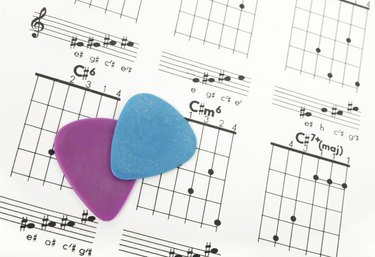
Whether you wish to create a tutorial helping others learn how to play certain chords or want to increase your own abilities, you can make your own chord charts -- also called chord diagrams -- using Microsoft Word. The key is setting up tables to represent fret strings and then adding dots to show finger placement. Once you make the basic tables, you can save the document as a template, as well, so that you can quickly produce more chord charts whenever you need them.
Step 1
Start Word and open a new blank document. Select the "Insert" tab. Click on "Table" and move the mouse over the table menu to select a "5 x 4 Table," which is a table with five columns and four rows. The six vertical lines represent the six guitar strings, the top horizontal line represents the nut and the five remaining horizontal lines represent frets.
Video of the Day
Step 2
Click on the table to select it. Select the "Layout" tab under Table Tools. Change the numbers in both the Height and Width boxes in the Cell group to "1.0" to create even square cells. Select the table again and click on the "Home" tab. Click the "Center" button in the Paragraph group to center the chart on the page. Alternatively, press "Ctrl-E."
Step 3
Save the chart as a template before adding details to it if you want to use it again later. Press the "F12" key at the top of your keyboard or select the "File" tab and click "Save As." Double-click "Computer." Choose "Word Template (*.dotx)" in the Save as Type box. Enter a name for the template in the File Name box, such as "Chord Chart Template." Click the "Save" button. Select "File," choose "New" and select "Personal" to use the template again.
Step 4
Click inside the first cell of the table and press "Enter" to move the table down on the page. Type the chord name above the table.
Step 5
Insert all fingerings using the Shapes menu. Use solid circles for finger placements. For open strings, insert a circle with a black line and white fill color. To represent a string you do not strum, insert an "X," which you will find under Equation Shapes. Select the "Insert" tab, click "Shapes" and choose the shape you want to use. Click on the fret where you want to place the shape, dragging or resizing it as needed.
Step 6
Print the diagram by pressing "Ctrl-P" or selecting the "File" tab and choosing "Print" and clicking the "Print" button.
Step 7
Save the chord chart by pressing "Ctrl-S" or clicking the "Save" button above the File tab. Enter a file name, choose the location and click "Save."
Video of the Day